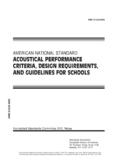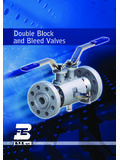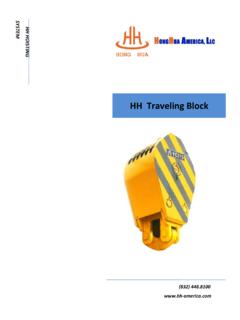Transcription of Controlling Sound Transmission through Concrete …
1 By WarnockThis Update discusses the various factors that affect Sound transmissionthrough different types of Concrete block walls, including single-leaf walls, double -leaf walls and walls with gypsum board attached. Knowledge ofthese factors will assist construction practitioners to design and build wallswith high levels of acoustic performance economically. Construction Technology Update No. 13 Concrete block walls are commonly used to separate dwelling units from each otherand to enclose mechanical equipmentrooms in both residential and office build-ings because of their inherent mass andstiffness.
2 The bending stiffness of the mate-rial making up the wall is also of these fundamental properties(mass and stiffness) can be altered by , there are additional factors thatneed to be considered in building high-quality walls. Single-Leaf Concrete block WallsMass per Unit AreaFor single-leaf walls, the most importantdeterminant of Sound Transmission class(STC) is the mass per unit area: the higherit is, the better. A single-leaf Concrete blockwall is heavy enough to provide STC ratingsof about 45 to 55 when the block surface issealed with paint or 1 shows measured STC ratings for single-leaf Concrete block walls from anumber of published sources.
3 The consid-erable scatter demonstrates that, whileimportant, block weight is not the only factor that determines the STC for this typeof wall. In the absence of measured data,the regression line in Figure 1 can be usedto estimate the STC from the block , Table 1 provides representa-tive STC values for 50% solid blocks thathave been sealed on at least one side. It shows the relatively modest effects of significant increases in wall thickness on STC. Adding materials such as sand or groutto the cores of the blocks simply increasesthe weight; the increase in STC can be Controlling SoundTransmission throughConcrete block WallsSome Basic Concepts Transmission Loss (TL) andSound Transmission Class (STC)For significant noise reduction betweentwo rooms, the wall (or floor) separatingthem must transmit only a small fraction ofthe Sound energy that strikes it.
4 The ratioof the Sound energy striking the wall tothe transmitted Sound energy, expressedin decibels (dB), is called the transmissionloss (TL). The less Sound energy trans-mitted, the higher the Transmission other words, the greater the TL, the betterthe wall is at reducing Transmission class (STC) is a single-number rating that summarizes transmis-sion loss data. It is obtained by fitting astandard reference contour to the data (seeFigures 2 and 3).2estimated from Figure 1. Adding Sound -absorbing materials to the cores is not effective because the Sound bypasses theinsulation, taking the more direct paththrough the 1 also shows that using heavierblock to get an STC rating of much more than50 leads to impracticably heavy STC ratings are more easily obtainedby adding layers of gypsum board mountedon studs or resilient (flexible) furring thatdo not have a solid connection to the Concrete block .
5 Effect of Porosity When the Concrete block is porous, sealingthe surface with plaster or block sealer significantly improves the Sound insula-tion; the more porous the block , the greaterthe improvement. Improvements of 5 to10 STC points, or even more, are notuncommon for some lightweight blockwalls after sealing. Conversely, normal-weight blocks usually show little or noimprovement after sealing. This improve-ment in STC in lightweight blocks is relatedto the increased airflow resistivity of theseblocks. The leakage of Sound through thematerial of the block is different only indegree from leakage of Sound through inadequate mortar joints.
6 To ensure goodsound insulation, mortar joints must alwaysbe properly finished that is, free fromobvious board attached directly toblocks by means of glue or screws does notseal the surface as well as plaster or paintsince the gypsum board does not bondcompletely to the blocks and behaves as aseparate layer. Sound radiated from thegypsum board continues to leak through theblocks. Table 2 provides examples of twovery different types of block and their rela-tive STC ratings. In each case, the plasterallows the Sound insulation of the wall toreach its full potential; the gypsum boarddoes not.
7 The effect of the plaster on thevery porous (wood-aggregate) blocks, whichhave been included for purposes of compar-ison, is particularly dramatic. block sealerwould yield the same result as 90-mm wood-190-mm block aggregate lightweight treatmentblocksconcrete blocksUnsealed1442 Gypsum 2946board on one facePlastered4349 Table for very porous wood-aggregateblocks and lightweight Concrete blocks sealed withgypsum board or plasterWall LightweightNormal Thickness, blockweightmmblockSTCSTC9043441404446190 464824047492904951 Table ratings for 50% solid normal-weightand lightweight block walls sealed on at least one sideFigure of block weight on STC for single-layer Concrete block walls65605550454035010203040 block weight.
8 KgSTCIn other tests carried out at IRC, a num-ber of double -leaf cavity block walls, inwhich the layers were structurally isolatedfrom each other, achieved STC ratings inthe range of 70 to 80. The constructionsprovided the least amount of structuralvibration Transmission that can be achievedin the laboratory, which is better than whatcan be achieved in normal practice. Inpractical situations, careful design, meticu-lous workmanship and skilled supervisionare needed for such walls to achieve theirfull block Walls withGypsum Board AddedAdding gypsum board supported on furringor studs at a distance from the surface ofthe block wall can greatly improve thesound insulation of the wall factors that govern the degree ofimprovement method of support ideally, thegypsum board should not be solidly connected to the block ; depth of the cavity (the distancebetween facing surfaces of the block andthe gypsum board).
9 Use of Sound -absorbing material inthe cavity between the gypsum boardand the surface of the the furring supporting the gypsum boardis rigid, Sound can travel directly through itfrom the gypsum board to the , if the furring is sufficiently flexible,the Sound will be attenuated. But the bestmethod of support for the gypsum board isthe use of independent studs that have nodirect connection to the block . Resilientmetal furring may be used on its own or incombination with wood 2 provides two sets of transmissionloss (TL) data for walls with unfilled cavitiesof two different depths, as well as data foran unfinished block wall.
10 The effect of theadded gypsum board on acoustic performanceis striking at high frequencies, the perform-ance of the walls with the gypsum board isbetter than that of the bare block wall; atlow frequencies, it is worse. There is adecrease in TL at low frequencies and anincrease in TL at high frequencies in bothwalls relative to the unfinished block Concrete block WallsIn principle, double -leaf masonry walls canprovide excellent Sound insulation. Theyappear to meet the prescription for an idealdouble wall: two independent, heavy layersseparated by an air space. In practice, constructing two block walls that are notsolidly connected somewhere is very difficult.









